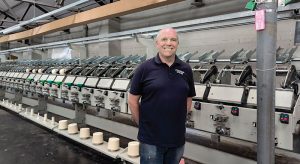
England-based textile dyeing firm cuts carbon footprint with innovative heat recovery system and facility upgrades.
TW Special Report
England-based Atkinson Dyeing, a specialist yarn dyeing facility established in 1978 and acquired by woollen mill AW Hainsworth in 2019, has undergone significant transformation to improve environmental performance and modernize operations. The centerpiece of this transformation is the installation of a state-of-the-art heat recovery system, which captures 60°C wastewater and uses it to preheat incoming cold water to 50°C. This system is designed to reduce the site’s reliance on gas, delivering a major reduction in carbon emissions. At its full potential, the system is projected to lower the facility’s gas bill by 20 percent and electricity by 10 percent.
This investment builds on a range of infrastructure and operational improvements made across the Atkinson Dyeing site in Keighley — a town in West Yorkshire close to the Haworth Moorland, which is known as Bronte country, so named for the famed literary Bronte sisters.
Atkinson’s winding area has been upgraded to increase efficiency. New 3D were fans installed to reduce dust and improve air quality, a new insulated roof was added, LED lighting was upgraded, and new windows were installed that increase natural light. Reusable cones continue to reduce plastic waste, while new, in-house-engineered yarn-stripping machines have improved speed and process control. The site also introduced computer-controlled dyeing machines, which reduce water consumption compared to traditional methods.
Water and chemical management has also been a priority. The site utilizes river abstraction rights to reduce its reliance on mains water and ensures that all used water is treated off-site, with no discharge returning to the river. To mitigate environmental risks, bunds have been installed beneath chemical storage areas to contain any potential leaks. There has also been a focus on recycling and reuse efforts, with all cardboard, plastic, and wood being recycled and repurposed where possible.
On the technical side, Atkinson Dyeing has implemented an OrgaTEX cloud-based planning system from Germany-based SETEX to enhance production traceability and scheduling across departments.
Richard Smith, operations manager at Atkinson Dyeing, commented: “In previous years, we’ve installed power-saving inverters on our machinery, switched to an electric forklift truck, and converted the oil powered boiler to a more efficient gas burner, which reduced energy usage by 64 percent.
“We still have a long way to go, but we’re proud of the progress made at Atkinson Dyeing. From facility upgrades to innovative technology and sustainable practices, we are continuously investing in our long-term vision for growth, environmental responsibility, and workplace well-being.”
The facility’s progress is closely monitored using a carbon intensity model that tracks emissions per kilo-gram of yarn processed. This method allows the team to maintain high levels of transparency and accountability while setting a clear baseline for future reductions. The improvements at Atkinson Dyeing form part of AW Hainsworth’s broader sustainability strategy, which is supported through Planet Mark certification and a formal road map towards reaching Net Zero.
With its blend of technology, infrastructure upgrades, and responsible resource management, Atkinson Dyeing is setting a clear course toward greater efficiency and lower emissions. The ongoing improvements not only strengthen its environmental credentials but also reinforce its role as a AW Hainsworth company.
2025 Quarterly Issue III




